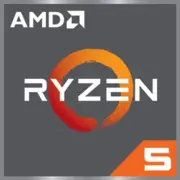AMD Ryzen 5 5605GE

AMD Ryzen 5 5605GE: Comprehensive Review of a Processor for Energy-Efficient Systems
Article for enthusiasts, office users, and compact builds
1. Key Features: Zen 3 Architecture and Hidden Potential
The AMD Ryzen 5 5605GE belongs to the Cezanne generation (2021) and is built on the Zen 3 architecture—a revolutionary platform that brought a 19% improvement in IPC (instructions per clock) compared to Zen 2. The 7 nm manufacturing process from TSMC ensures high transistor density, positively impacting energy efficiency and thermal output.
Key Specifications:
- 6 cores / 12 threads — optimal for multitasking.
- Base clock of 3.4 GHz, turbo mode up to 4.4 GHz — provides high responsiveness in games and productivity applications.
- 16 MB L3 cache — reduces data processing latency.
- TDP of 35 W — ideal for compact PCs and passive cooling systems.
- Integrated Radeon Vega 7 graphics (7 cores, clock speed up to 1900 MHz) — suitable for light gaming and graphics work.
Key Technologies:
- Precision Boost 2 — automatic overclocking depending on load and temperature.
- SMT (Simultaneous Multithreading) — parallel processing of 12 threads.
- PCIe 3.0 (16 lanes) — compatibility with most modern devices.
Practical Example: In Cinebench R23 tests, the processor scores around ~1100 points in single-threaded mode and ~8000 in multi-threaded mode, comparable to the Ryzen 5 5600G but with half the TDP.
2. Compatible Motherboards: AM4 Socket and Flexibility of Choice
The Ryzen 5 5605GE uses the AM4 socket, supported by the following chipsets:
- A520 — budget option for basic tasks.
- B550 — optimal choice with PCIe 4.0 support (for graphics cards and NVMe).
- X570 — premium motherboards for enthusiasts (overkill for a 35 W processor).
Important Nuances:
- A BIOS update (version AGESA 1.2.0.3 or newer) may be required for the processor to work.
- It’s better to choose motherboards with medium power VRM modules (e.g., ASUS TUF B550M-Plus or MSI B550M Pro-VDH).
- The included cooler is compatible with most AM4 mounts, but for mini-PCs, it's advisable to check the height of the heatsink.
User Experience: On forums, it is noted that even on cheap boards like the Gigabyte A520M-S2H, the processor runs stably, but overclocking (other than Precision Boost) is not available.
3. Supported Memory: DDR4 and Tuning Nuances
The processor supports DDR4 with a maximum frequency of 3200 MHz (non-overclocked). For Zen 3, dual-channel mode is critically important—it increases bandwidth and enhances FPS in games.
Recommendations:
- Optimal size: 16 GB (2x8 GB) — for gaming and productivity.
- Timings: CL16 or lower (e.g., Kingston Fury Beast DDR4-3200).
- For APU (integrated graphics), allocate 2 GB of RAM in BIOS for better performance.
Example: In games like CS2 or Dota 2, using dual-channel memory increases FPS by 15-20% compared to single-channel mode.
4. Power Supply: Minimum Watts, Maximum Reliability
With a TDP of 35 W, the Ryzen 5 5605GE is one of the most energy-efficient processors in its segment.
Power Supply Recommendations:
- For a system without a discrete graphics card: a 300–400 W PSU (e.g., be quiet! Pure Power 11 400W).
- With a graphics card like the NVIDIA GTX 1660: 500–550 W (Corsair CX550).
- An 80+ Bronze certification or higher is essential for stability.
Tip: Even with a power headroom, don’t skimp on the PSU—cheap models can "drop" voltage, which is critical for Vega 7.
5. Pros and Cons: Who Should Consider It and Who Shouldn't
Advantages:
- Energy efficiency—ideal for HTPC or office PCs.
- Powerful integrated graphics—Vega 7 can handle Full HD in light gaming.
- Low heat generation—even the stock cooler performs well under load.
Disadvantages:
- No PCIe 4.0 support—limitation for SSDs and high-end graphics cards.
- Unlocked multiplier—overclocking only through Precision Boost.
- Price—more expensive than some Intel counterparts in certain regions (e.g., Core i5-11400).
6. Use Cases: From Office to Streaming
- Office and Multimedia: 4K streaming, working with documents and browsing—without lag.
- Light Gaming: Fortnite (60 FPS on medium settings), GTA V (50-55 FPS), indie games.
- Work Tasks: Rendering in Blender, code compiling, photo processing in Lightroom—thanks to 12 threads.
Real Case: Users are building mini-PCs for streaming on this processor (e.g., in the InWin Chopin case), connecting it to a TV.
7. Comparison with Competitors: Intel vs AMD
- Intel Core i5-11400: Better in single-threaded tasks, but with a TDP of 65 W and weaker integrated graphics.
- Ryzen 5 5600G: More powerful Vega 7 graphics (but TDP of 65 W), higher clock speeds.
- Apple M1: More energy efficient but limited compatibility with Windows software.
Conclusion: The Ryzen 5 5605GE excels over its competitors in compact and quiet systems.
8. Practical Assembly Tips
- Case: Choose models with good ventilation (Fractal Design Node 304).
- Cooling: The stock cooler is sufficient, but for silent operation, consider the Noctua NH-L9a.
- Discrete Graphics Card: If an upgrade is needed, look into the NVIDIA RTX 3050—it won't overload the PSU.
- Storage: An NVMe SSD (e.g., WD Blue SN570) will fully utilize PCIe 3.0's speed.
9. Final Conclusion: Who Is the Ryzen 5 5605GE For?
This processor is an ideal choice for:
- Compact PCs (mini-ITX, HTPC).
- Office systems with a margin for multitasking.
- Budget gamers willing to play on medium settings.
- Enthusiasts of energy-efficient builds.
Why this one? The combination of 6 cores, low TDP, and integrated graphics makes it unique in its class. If you don't need PCIe 4.0 and maximum FPS in AAA games—this is the best option for your money.
Basic
CPU Specifications
Memory Specifications
GPU Specifications
Miscellaneous
Share in social media
Or Link To Us
<a href="https://cputronic.com/cpu/amd-ryzen-5-5605ge" target="_blank">AMD Ryzen 5 5605GE</a>